Posts filed under 'Accessories'
April 12th, 2007
Jason Dunn
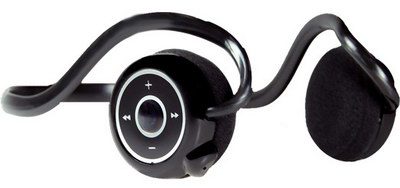
People with Windows Mobile devices – whether they be network-connected smartphones with the latest EVDO or UMTS wireless technology, or PDAs using 802.11b WiFi – all have one thing in common: they want to get rid of all the wires. I can recall the days when PDAs required connecting to a phone line or CAT5 Ethernet cable in order to get Internet access (yes, I am getting old). Now that we have the wireless networking part more or less nailed, there’s just one more wire that’s got to go: the cable connecting headphones for listening to music. Helium Digital’s HDBT-700 Bluetooth headphones aim to do exactly that.
These over-the-ear headphones (weighing in at a light 50 grams) are Bluetooth 2.0 compliant, with a range of around 30 feet. It requires that the connected device supports A2DP or AVRCP Bluetooth profiles. Most modern Windows Mobile devices have support for both profiles, but you’ll want to double-check with your device manufacturer to make sure. The HDBT-700 uses a rechargeable Lithium Ion battery, with an estimated run time of 6.5 hours. That battery estimate seems about right to me, though I never did any scientific testing. A built-in microphone is also included, featuring echo-cancellation and noise suppression – this allows you to use it with instant messaging programs for sending short voice clips, voice command software, and other functions. I tested it with Microsoft Voice Command and it worked really well – I was able to go from listening to music to checking my upcoming appointments, all without having to touch my smartphone.
Dual pairing, another feature, allows the headphones to be paired with two devices: for most users this will be a mobile phone and an audio player of some sort. Unfortunately, since most digital audio players lack Bluetooth, most people will end up partnering with their mobile phones. Windows Mobile phones – when combined with a large storage card – make excellent digital audio and video players, especially when combined with some of the great third-party software out there today.
All of the controls for HDBT-700’s are on the right earpiece: next and previous allow you to go forward and backward, skipping songs quickly. There are plus (+) and minus (-) buttons as well – serving as a volume up/down in most applications. The center button functions as the play/pause button in Windows Media Player 10 Mobile. Pressing and holding the button is how you turn the headphones on, off, and initiate the Bluetooth pairing process. The pairing process with my Windows Mobile 5-based T-Mobil Dash was painless: I put the HDBT-700 headphones in pairing mode by pressing and holding the power button until it started to blink in alternating a red and blue flashing light pattern. Then on the smartphone I initiated a search for new Bluetooth devices – after a few seconds it found the headphones and after authenticating with the passkey (four zeros) the pairing was complete. Whenever Bluetooth on the smartphone is turned on, and the headphones are powered up, the connection is made automatically. The entire process is quite seamless.
So how do the Helium headphones sound? It really depends on what you’re used to – in my case, my day to day listening headphones are Ultimate Ears super.fi 5’s – small, in-ear headphones that block out 90% of outside sound and boast a dual-driver design that delivers superb sound and great bottom-end. But they’re also $250 USD and come with an incredibly irritating cable that never seems to go straight. It’s unfair to compare the HDBT-700’s to headphones like the super.fi 5’s, because they’re completely different form-factors. Clearly, anyone who wants the ultimate in sound fidelity isn’t going to go for the over-the-ears headphones – the HDBT-700’s appeal to a different type of person, someone who’s willing to accept less than great audio quality but gains all the benefits that Bluetooth headphones provide.
So with that proviso out of the way, we return to the question of how they sound: the answer is, pretty good, but it also depends on what kind of smartphone you have. I tested the headphones on two Windows Mobile 5 devices: a T-Mobile Dash, and a Treo 750. The results were interesting – on the T-Mobile Dash, I could hear mild distortion and static in every song (kind of like a radio being not quite locked into the right station), but only when the singing started, meaning it’s likely an audio frequency issue. On the Treo 750, the audio quality was just fine – there wasn’t any static at all. This is a frustrating issue of course, because no one wants to buy a new set of headphones and hear static mixed in with their music. My fellow MVP, Werner “Menneisyys” Ruotsalainen, has had a lot to say on this issue, so I’ll direct you to his write –up for more information on the topic.
The headphones can’t overcome the physical limitation of not being inside the ear canal though, nor completely encasing the ear, which means very limited bottom end signal. Music that sounds best would include anything that relies more on sonic highs and mids – think Celtic and vocal music – but anything rock-related doesn’t sound quite right, and you can forget about those drum and bass-only tracks. Because of the headphone design – hanging over your ears rather than going into your ear canal – these headphones are ill-suited for use in a noisy environment. I tested them in a variety of locations – sitting on my couch at home or in a library, the lack of noise blocking wasn’t an issue at all. On a plane right next to a window? As they say in Brooklyn, “fuggedaboutit!”” – the noise level reduced my music to pure sonic mush, even at maximum volume. That’s a problem that would plague any over-the-ear headphones though (including the horrible airplane headphones) and not a particular design flaw in the HDBT-700’s.
The HDBT-700’s can be purchased directly from Helium Digital for approximately $70 USD. The HDBT-750 is a $115 USD kit with headphones identical to the HDBT-700 but it also includes a Bluetooth adaptor that you can connect to any 3.5 mm audio jack to turn any device into a Bluetooth device.
November 22nd, 2006
Jason Dunn
If there’s one thing that every Windows Mobile device owner wishes they could forget about its battery life. It doesn’t matter if you use your device for productivity, gaming, music, video, or email – everything takes power. Who wants to think about recharging their devices? There’s nothing exciting about that – the fun comes in using them! Sadly, battery life still isn’t at the point where a single charge will last weeks, so until that happens we need to have strategies in place for getting as much use out of our Windows Mobile Smartphones and Pocket PCs as possible. If you’re the kind of user who recharges daily from home or work, you may not have to think about battery life much – even a heavily used Pocket PC or Smartphone should last a full day. If you do any traveling though, or don’t recharge your device every day, there are some power accessories that will make your battery life last a lot longer. There are many companies making accessories like the ones I mention in this article, but I’ve selected Pocket PC Techs accessories to look at for two reasons: they’re very high quality, and they just happen to have sent a few of them my way.

An important note: the Pocket PC Techs Web site requires the selection of a device before you can access their products, so all the links in this article go to products for an I-Mate Jasjar. If you wish to purchase any of these products for yourself, go to the Pocket PC Techs Web site and select the “Pick/Change Your Unit” link at the top. From that point onward, you’ll only see accessories that are compatible with your Pocket PC or Smartphone. They’re always adding new devices and accessories, so if your device isn’t listed, check back in a few weeks and it just might be.
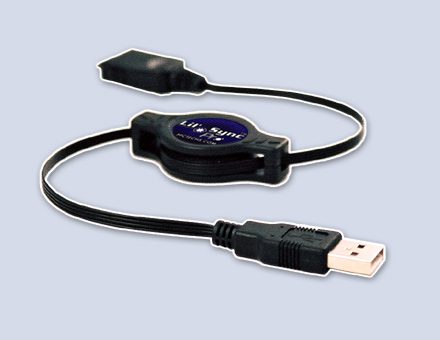
The heart of the Pocket PC Techs system is the Lil’ Sync Pro retractable cable. This cable serves as the power and synchronization bridge into your device. In my case, I have an I-Mate Jasjar, so I requested the miniUSB version, which is the most common type of connector for Windows Mobile devices, but there are different types of cables offered for various Pocket PCs and Smartphones. One end of the cable connects to your device, and the other end terminates in a standard USB cable. USB ports are everywhere, on every modern PC around, so this cable will be able to draw power from almost any PC. The cable serves a dual purpose: it will allow you to synchronize with a PC, but if your Windows Mobile device supports charging over USB (nearly all do) you’ll also be able to recharge it. Charging over USB is slower than direct AC power, but the convenience it offers overrules any concerns about how long it takes to charge. The cable is retractable and weighs only two ounces, making it highly portable – it extends to 50 inches in total, allowing you to reach almost any USB port and still work with your device at the same time. The cables sell for $19.99 USD.
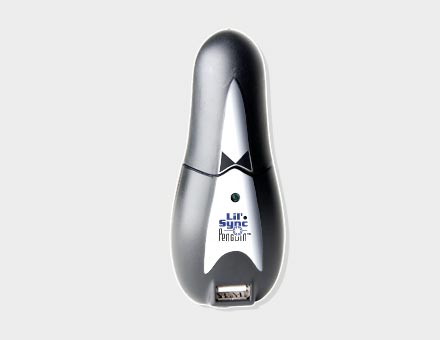
Next we have the Lil’ Sync Penguin. It has a curious name, and looks a little “cute” to be a technology accessory, but just like the Millennium Falcon, it has it where it counts. The sturdy plastic exterior has a removable top, underneath which houses an auto adapter. Plug this into any automobile cigarette lighter, and you’ve got power – it handles all the electrical conversion and regulation. The back side has flip-up prongs that allow you to connect it to a wall socket for AC power, while the front bottom has a female USB port – this is where you connect the Lil’ Sync Pro cable. If you’re into specs, the Penguin supports AC input of 100 to 240 V; DC output of 5.1 ~ 5.6 V, auto input of 12 to 24 V; DC output of 5.1 to 5.6 v, and a current output of 1,000 mA ± 10%. The Lil’ Sync Penguin sells for $24.99 USD. If you live in Europe, or find yourself there often, there’s also an EU version that functions exactly the same.
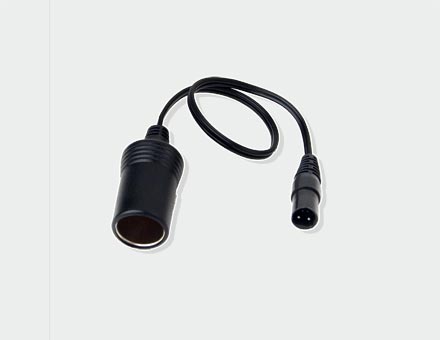
The Lil’ Sync Airline Power Adaptor does one thing: it allows you to take your Lil’ Sync Pengiun and draw power from the EmPower Airline Power plus that many airplanes have. One end of the cable plugs into the 12 volt EmPower plug, and the other end accepts the connection from the Lil’ Sync Penguin. So in order to recharge your device on an air plane, you’d need three things: the Lil’ Sync cable, the Lil’ Sync Penguin, and this cable. I haven’t had a chance to test this on an airplane yet, but it would sure come in handy for those long flights. It can be purchased for $14.99.
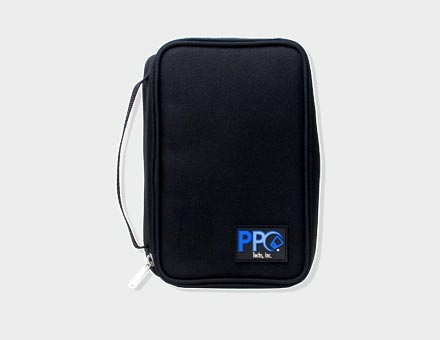
Once you have all these accessories, how do you carry them? Why in the Lil’ Sync Power Accessories Carrying Case of course. This simple zippered Nylon carrying case has the Pocket PC Techs logo on the front, and a short carrying handle on the side. On the inside, one half is a single-zipper mesh pouch, measuring 8 inches by 5 inches. This area is good for storing assorted cables or even your Windows Mobile device. The other half of the case has three segmented mesh compartments, open at the top. I was able to fit all of my Pocket PC techs power accessories in this carrying case, along with several other cables and even a small portable battery. The case is sold for $19.99 USD, and makes a good all-around gadget bag.
Pocket PC Techs has a few other power-related accessories, including the AA Battery Adaptor (which allows you to use AA batteries to recharge your device), and several DUO adaptors which allow you to recharge your device more quickly, and from a completely dead battery.
October 30th, 2006
Jason Dunn
“While at Mobius, Jenneth and I were both presented with a set of Ultimate Ears super.fi 5 Pro Earphones. It seemed redundant to write separate reviews about the same product, so we decided to combine forces and write a dually to post on both our sites - we’re trying something new! For reference: My remarks will be in the regular page colors, and Jenneth’s will be in blue and italicized.** Just because you have the finest digital music player that money can buy doesn’t mean that it will sound all that better if you are still using the basic earbuds it shipped with. That’s assuming you can even get the OEM earbuds to stay in your ear!”
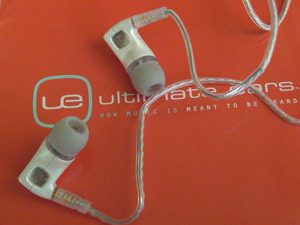
I figured that since I just posted my own review of these headphones, it would be worthwhile to link to another opinion on them - Gear Diary has a cool two-person review that has a lot of photographs and details that my review didn’t have. Check it out!
October 23rd, 2006
Jason Dunn
Headphones are one of the most important parts of any music listening experience – together with the audio player itself and the quality of the encoded music – but most digital audio players come with extremely cheap headphones. Perhaps it’s because the manufacturers know the first thing many people do is discard included headphones, and thus they don’t want to invest any significant money in the bundled headphones. Or, perhaps it’s because quality headphones cost money (which would raise the cost of the overall product), and a good portion of the public doesn’t know how good music can really sound with great headphones. Regardless of the reason why bundled headphones are usually of poor quality, if you’re still using the standard headphones that came with your Windows Mobile Pocket PC or Smartphone, your music isn’t sounding as good as it should.
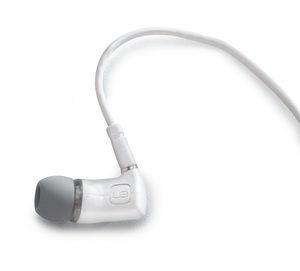
The Ultimate Ears super.fi 3 Studio headphones
In my search for headphones to review, I came across Ultimate Ears – they’re a company that has historically made custom stage performance headphones for professional musicians, and have recently taken that core technology and brought it down-stream to a line of consumer products. With the likes of Metallica and Third Day (check out the complete list) using their professional products, it boded well for the quality of their consumer products, so I was looking forward to checking out what they had to offer. I had initially wanted to look at the Creative Zen Aurvana headphones, but repeated requests for a pair were declined or ignored, so I looked elsewhere. Am I ever glad I did!
I tested three sets of headphones, running the gamut from free to quite expensive: a pair of headphones that came bundled with a Sandisk MP3 player (which are actually slightly better than most bundled headphones I’ve used, but adequately represent the headphones that usually come with Windows Mobile Pocket PCs and Smartphones), a pair of Ultimate Ears super.fi 3 Studio headphones ($99 USD MSRP), and a pair of super.fi 5 Pro headphones ($249 USD MSRP). All three were tested using a Windows Mobile 5-based iPAQ 1950 Pocket PC, using 256 kbps MP3 files. The iPAQ’s system volume level is a six-level slider, and I had it set on the fourth-loudest level. The volume setting inside Windows Media Player 10 Mobile, the application I used for the tests, was set to 80%. This is a reasonable middle-ground volume level, though I did crank up the headphones to the point of causing myself pain – the Ultimate Ears headphones are loud! To round out the testing I also listened using my laptop and a Creative Zen Vision:M audio player.
For testing purposes, I decided to focus on a common real-world scenario: use while traveling. It’s easy to test headphones in a quiet room, but most people use headphones while mobile – working out in a gym, traveling on a plane, or sitting on a bus. I decided to do my tests in a car where I was a passenger on a five hour highway trip. The driver and another passenger were conversing most of the way, and listening to music on the car stereo, so between that and highway road noise in a Mini Cooper, it seemed like a difficult situation for headphones to shine. In terms of what songs I used, I selected a cross-section of music (I listened to many more songs than these using the super.fi headphones, from a variety of genres and styles, but these were the four songs I focused on the most using the iPAQ 1950):
- Stevie Wonder, Superstition – this classic song was recorded in the 1970’s, and the drums, bass, and guitar all have a very smooth, natural sound.
- Plumb, Boys Don’t Cry – a modern pop track with an ethereal keyboard intro, soft female vocals, and a layered arrangement that explodes into a high energy chorus with electric guitars at the end.
- The Beatles, Lovely Rita – it doesn’t get more classic pop that the Beatles, and this 1960’s song has lush vocals, an energetic bass line, crisp piano, and copious amounts of subtle background noises from the old-school recording process.
- Click Five, Just The Girl – a song typical of current pop, the volume and energy level of this track are typical for three-chord rock (and the recording is loud). Crunchy electric guitar, thumping bass, pounding drums, and tight multipart vocal harmonies make this a good representation of modern recordings.
Testing headphones is even harder than testing audio speakers, because not only do you have the inherent personal bias of what subjectively sounds good or not, but you also have only one pair of ears: there’s no way to instantly switch from one pair of headphones to another, as you can do with speakers, to hear how each set handles a part of a certain song. Instead, you have to listen to a part of a song, switch headphones, and then try to remember how it sounded with the first pair of headphones. It sounds easier than it is – especially when the differences are slight. I’ve been using the superfi.3 headphones for almost a month now, so I had a good feeling for how good they were with a variety of music, but with the sample songs I focused on how each pair of headphones impacted the overall experience of listening to the music.
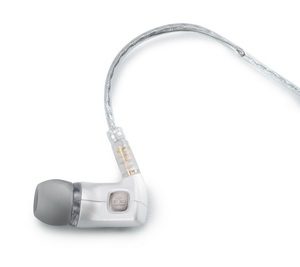
The Ultimate Ears super.fi 5 Pro headphones
So how did the super.fi headphones actually sound? In a word: amazing. Strong bass response, crisp high-end, and luscious mid-range. Every song I listened to sounded superb. Not surprisingly, the “freebie” headphones sounded horrible in comparison. One of the biggest issues was that although they were in-ear headphones, they were not designed to create a seal in the ear canal. Because of that, the sound going into my ear drum was equal part music and external noise. To combat this, most people crank up the volume, which ends up making the music muddy-sounding as many headphones can’t handle high volume (nor can most ear drums for that matter). It also has the side effect of irritating everyone around them. The Ultimate Ears products, on the other hand, let you hear nothing but the music, so you can listen at a lower volume – and the super.fi’s present subtle elements in the song that you probably haven’t heard before. If you normally listen to music using desktop computer speakers, you might be quite surprised at how different your music sounds when heard through the super.fi headphones.
The two models of super.fi headphones are virtually identical in design – both are over-the-ear, in-ear headphones. That means that they are placed in your ear canal, and rely on blocking the canal to reduce outside noise. To this end, the supfer.fi headphones include four different sizes of soft rubber plugs, and one pair of soft form plugs. The ideal pair is the one that feels the best, but also fills the ear canal completely and creates a light suction feeling. This makes them “noise reduction” headphones, rather than the more effective (but battery-powered) active noise-cancellation headphones that use microphones and white noise to block external noise. On planes and in cars, I found the noise blocking abilities of the super.fi headphones to be quite effective - I’d say they block about 80% of the outside noise.
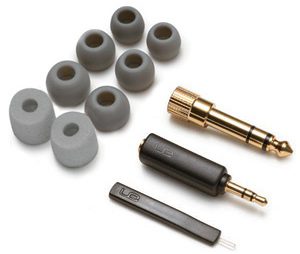
The super.fi 5’s accessories - mine came with an extra ear insert not shown.
Putting on the super.fi headphones takes a bit of practice – they have to be inserted then twisted backward and toward you to create the suction necessary for proper sound. The stiff wire coming out of each headphone is then bent down over the back of the ear to secure the headphone in place. The first few times I put them in, I found the process awkward, but now it’s quick and easy for me. Ultimate Ears has a short demonstration video that shows you how to install them properly. Both super.fi headphones come with a small metal carrying case, the aforementioned rubber plugs, and a small tool to clean the ear wax off the plugs. The super.fi 5’s also include a 1/4″ jack (useful for musicians who want to use them as audio monitors).
One thing I wish was different was the metal carrying case – it’s just an empty container, there’s no spooling mechanism for storage, so you end up just cramming the headphones in and trying to get the lid shut. Not ideal, and certainly not impressive in the case of the expensive supfer.fi 5’s. There’s an optional winding spool for the carrying case that’s sold seperately, but it should be standard on headphones this expensive (both pairs). I also found the cable to be a bit too stiff - it’s a bit frustrating to have a cable going in random directions instead of just lying down flat.
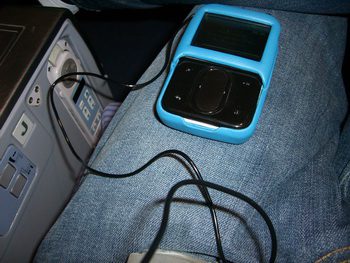
See how the cable doesn’t lay flat? A bit irritating.
The real question isn’t whether the Ultimate Ears super.fi headphones are worthy of replacing the bundled headphones you got with your device – they absolutely are. But which pair of super.fi headphones represents the best value? There’s a big price difference between $99 and $249, and I believe that the supfer.fi 3’s (the $99 pair) are in the sweet spot between price and quality. The super.fi 3’s are light years better than any bundled headphones, but the $249 super.fi 5’s don’t sound good enough to justify the difference in price with most music. The exception here would be if you happen to listen to music where subtlety and nuance are important – say, jazz or classical. I found that the super.fi 5’s allowed me to hear things that I missed with the super.fi 3’s – on the Stevie Wonder track, I heard a slight recording hiss, could hear the cymbals on the drums more clearly, and the kick drum had more presence. On another song, Creed’s Pity for a Dime, I could hear the sound of a guitar pick scraping the guitar strings before the guitar player strummed. That’s impressive sonic detail. In almost every other way, however, when I switched between the super.fi 3’s and the super.fi 5’s, I had a hard time telling the difference between the two. The basic elements of the song were delivered with equal amounts of power and punch by both sets of headphones.
The bottom line is that either Ultimate Ears product will dramatically enhance the quality of your music experience with your Windows Mobile device. I can highly recommend either product, and if I had an “Editors Choice Award” here at the Two Inch View, both supfer.fi products would win one.
August 1st, 2006
Jason Dunn
“SanDisk ® Corporation today introduced a 2-gigabyte (GB) microSD ™ card – the largest capacity of the world’s smallest removable flash memory card – to meet demand for a new generation of MP3 music phones, including the forthcoming Verizon Wireless Chocolate by LG mobile phone. Using the SanDisk microSD card, the Verizon Wireless phone can store up to 1,000 digital songs downloaded from the company’s V CAST music service. The card, which is sold with an adapter that enables it to fit into a standard-size SD ™ slot of other devices, will debut in the U.S. exclusively at 1,900 Verizon Wireless stores for the next 60 days. Internationally, it will be sold by a variety of mobile retailers.”
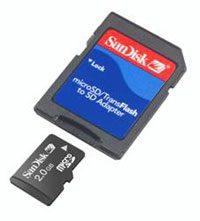
I just published my review of the 1 GB Sandisk microSD card recently, and it’s outdated already! I shouldn’t be surprised of course, but I wasn’t expecting to see 2 GB quite this quickly. It’s impressive to see how the development in Flash memory has resulted in a quick ramp-up of the storage capacity in this format. The 2GB cards will sell for $99 USD, though for the first 60 days they’ll only be available in Verizon wireless stores. This links in with the LG Chocolate phone promotion that Verizon has been promoting heavily lately. One of those would sure look good in my Qtek 8500… 
Previous Posts











